Adam Nelson,"The Giant Killer"In his quest for a gold medal and the world record, this powerful, steroid-free shot-putter proves that bigger is not always the bestBy Kim Goss Published: Summer 2004 Within track and field, one of the premier events is the shot put. Those who excel in this event gain the respect and admiration of any strength athlete because it represents power. Power is the ability to produce the maximum amount of force in the minimum amount of time, and research by sport scientists has shown that shot-putters produce more power than any other athletes. At the upcoming Olympic Games, the man who appears destined to prove himself to be the most powerful athlete in the world is Adam Nelson. A 28-year-old from Atlanta, Georgia, Nelson does not have the immense physical presence of most elite shot-putters. Only six feet tall and having competed for the past several years at a bodyweight of around 250 pounds, he appears more suited for the hammer throw. But his incredible explosiveness and precision throwing technique make him one of the best ever at the sport and a serious threat for the world record, which in this event has stood since 1990. One of Nelson’s biggest advantages in throwing is his use of torque, which involves the separation between the hips and the shoulders. In an interview by Mark Butler, Nelson described his technique. “Your hips go in one direction and your shoulders go in the other. “It’s about how long a push you can get on the ball by separating the hips from the shoulders. I do that very well. If you watch when I come through the middle of the circle you’ll see my feet continue to go towards the front, while my shoulders actually wrap up and go in the opposite direction. I’ve been told it looks kind of ‘herky-jerky,’ but my body’s moving in two different directions at the same time. When I release, there’s a lot of reflex action there.” A Base of Power The Nelson family is a family of athletes. His father was a center for Mississippi State; his sister, Sarah-Kate, was a soccer player for Dartmouth; and his brother, Grant, played rugby at the University of Colorado. Adam Nelson’s athletic career originally focused on football. He started as a linebacker at Dartmouth, and when, as he says, his “butt got bigger,” he was moved to defensive tackle. The first time Nelson competed in the shot put was in eighth grade, but he certainly didn’t do much to impress his coaches. “Actually, I was awful!” says Nelson. “There were five other shot-putters in my eighth-grade class, and I ranked number four or five.” But Nelson persisted, and in high school he captured the state title two years in a row. He went on to win the world juniors with a personal best of 60-2. His progress through college and leading up to the Olympic trials was impressive, as shown below: 1995 59-11.25 1996 62-9.5 1997 64-4.5 1998 67-6.5 1999 67-8.75 At the 2000 Olympic trials, on his final throw, Nelson won the event with a personal best of 72-7.0, which ranked him number one in the world by Track and Field News. He then captured the silver medal at the Olympic Games, and since then he has won two silver medals at the world championships and two year-end world rankings as number one. He also improved to a personal best of 73-10.25. Last year at the world championships in France, Nelson placed second behind Andrei Mikhnevich of Belarus, who 19 days earlier had completed a two-year suspension for drug use. Nelson’s response to losing to a former drug user is “As long as he’s clean here, that’s fine. He was tested during the whole suspension and was clean.” In his defense, Mikhnevich said he tested positive for gonadotropin, a protein hormone essential to women during pregnancy and which is produced by the pituitary gland. He blamed the mistake on his doctor. When the steroid THG was attracting so much media attention this year, three throwers from the US were identified as having used THG. Speaking at a conference sponsored by USA Track and Field, Nelson said that in the long run the scandal would have long-term benefits because elite athletes are often considered role models, and the drug issue “sends the right message to athletes out there who are considering cheating.” In the short-term, however, Nelson says the media coverage the controversy received could give the mistaken impression “that everybody is on drugs again.” Nelson says that track and field is making a concerted effort to clean up the sport’s image with a strict drug testing program. “If the media would look at the statistics they’d see that drug use is not as prevalent a problem as they think it is. In this country we get tested, out of competition, probably 6 to 8 times a year – at least I do. I’ve even been tested twice in one day by two different organizations! We make ourselves available to the drug testing agencies 24 hours a day, seven days a week, no matter what we’re doing. The bottom line is that the athletes who are doing drugs are going to get caught.” The current world record holder in the shot put is Randy Barnes, who is serving a lifetime suspension for drug use, being tested positive in 1990 and then again in 1998. Nelson sees that record (75–0.25) as tainted, even though Barnes had passed the drug test when he broke the record. “You don’t start taking drugs after you break the world record – let’s be honest!” Poliquin Power After last year’s world championships, Nelson learned about the success of Charles Poliquin, a strength coach who is owner of the Poliquin Performance Center in Tempe, Arizona. Nelson thought Poliquin might be able to take him to an even higher level. Because Nelson is relatively light for a shot-putter, much of Poliquin’s early preparation was designed to increase Nelson’s bodyweight. About Nelson’s previous attempts to add weight, Poliquin commented, “He always did try, but he had a hard time doing it.” According to Poliquin, in seven years of testing athletes he’s seen only one who had what he would consider a “normal system.” Nelson was not that one, as testing by Poliquin’s team of doctors discovered that a specific bacterium called proteus mirabilis was affecting Nelson's digestive system, especially his ability to assimilate protein. Within three months he gained 25 pounds of solid muscle and even decreased his body fat by five percent. Nelson says his goal is to add another 15 pounds of muscle before the Olympics. “I thought I was overtraining or just stressed out,” says Nelson. “Once we corrected that problem, everything went back into place again. I have more energy for training and I’ve gotten so much stronger this year.” Another priority in Nelson’s training was developing muscular balance to prevent injuries. “Adam’s current training didn’t address muscular balance, so we worked a lot of antagonist muscles to the shot put,” says Poliquin. “We did a lot of chin-ups, fat bar work, and a lot of work with partial movements, bands and lifting chains. “One reason that lifting chains work so well is they are one of the few methods that can improve both explosive power and maximal strength at the same time.” Adds Nelson, “Chains force you to continually push yourself to accelerate though the lift, rather than keeping a steady pressure. We used them for core lifts such as inclines and squats.” This will give you an idea of how strong Nelson has become since addressing his health issues and using these unique training methods: When Nelson started with Poliquin, he could incline press 385 pounds using a 3-inch-thick bar; now he does 525. Poliquin alters his training strategies to accommodate the requirements of various field athletes. He comments, “The different implements require different amounts of force in the force-velocity curve. In other words, the heavier the implement, the stronger the athlete has to be. The hammer throw requires more strength than the discus or javelin, and the shot put requires the most explosive strength. Thus, to use a simple example, a hammer thrower may need to concentrate more on the squat, whereas the shot-putter ma |
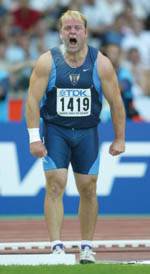 |
|
Adam Nelson |
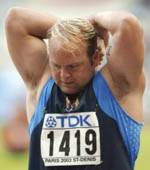 |
|
Within just three months of working with strength coach Charles Poliquin (right), Nelson gained 25 pounds of muscle and lost 5 percent bodyfat. |
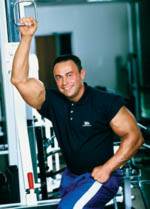 |
|
Within just three months of working with strength coach Charles Poliquin (right), Nelson gained 25 pounds of muscle and lost 5 percent bodyfat. |
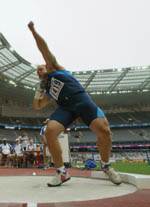 |
|
One of Nelson's biggest advantages in throwing is his use of torque, which involves the separation between the hips and the shoulders. |
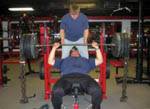 |
|
Thanks to specialized work that included attaching lifting chains to barbells, within six months Nelson increased his incline bench press from 385 pounds to 525 pounds. |